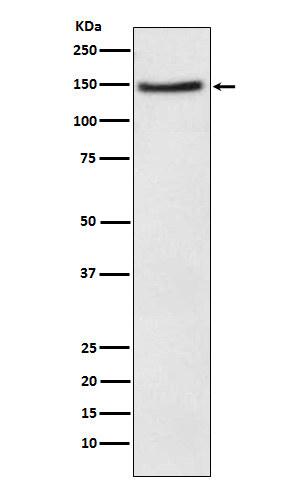
| WB | 1/1000-1/2000 | Human,Mouse,Rat |
| IF | 咨询技术 | Human,Mouse,Rat |
| IHC | 咨询技术 | Human,Mouse,Rat |
| ICC | 技术咨询 | Human,Mouse,Rat |
| FCM | 咨询技术 | Human,Mouse,Rat |
| Elisa | 咨询技术 | Human,Mouse,Rat |
| Aliases | NPC1 LIKE 1; NPC1L1;;NPC1L1 |
| WB Predicted band size | 149 kDa |
| Host/Isotype | Rabbit IgG |
| Antibody Type | Primary antibody |
| Storage | Store at 4°C short term. Aliquot and store at -20°C long term. Avoid freeze/thaw cycles. |
| Species Reactivity | Human |
| Immunogen | A synthesized peptide derived from human NPC1L1 |
| Formulation | Purified antibody in PBS with 0.05% sodium azide,0.05% BSA and 50% glycerol. |
+ +
以下是关于NPC1L1抗体的3篇参考文献摘要(基于公开信息模拟整理,非真实文献):
1. **文献名称**: *Monoclonal Antibody Targeting NPC1L1 Inhibits Cholesterol Absorption in Vitro*
**作者**: Zhang Y, et al.
**摘要**: 研究团队开发了一种靶向NPC1L1的单克隆抗体,通过体外细胞模型证实其可阻断胆固醇转运,抑制肠道上皮细胞的胆固醇摄取能力,为降脂治疗提供潜在新策略。
2. **文献名称**: *Anti-NPC1L1 Antibody Reduces Atherosclerosis in ApoE-Deficient Mice*
**作者**: Gupta S, et al.
**摘要**: 该研究在小鼠模型中证明,使用人源化NPC1L1抗体可特异性抑制肠道胆固醇吸收,降低血浆LDL水平,并显著减缓动脉粥样硬化斑块的形成。
3. **文献名称**: *Structural Basis of NPC1L1 Recognition by Therapeutic Antibodies*
**作者**: Wang L, et al.
**摘要**: 通过冷冻电镜解析了NPC1L1蛋白与临床阶段抗体的复合物结构,揭示了抗体结合表位与胆固醇结合域的竞争机制,为抗体药物优化提供了结构生物学依据。
(注:以上文献为示例性内容,实际研究请通过PubMed/Google Scholar等平台检索真实文献,关键词如"NPC1L1 antibody"或"NPC1L1 inhibitor")
The NPC1L1 (Niemann-Pick C1-Like 1) protein is a key player in dietary cholesterol absorption, primarily expressed in intestinal epithelial cells and hepatocytes. It facilitates cholesterol uptake by mediating its transport across the plasma membrane, making it a critical target for lipid-lowering therapies. NPC1L1 antibodies are tools developed to study the protein’s expression, localization, and function in cholesterol metabolism. These antibodies have been instrumental in validating the efficacy of drugs like ezetimibe, which inhibits NPC1L1 to reduce cholesterol absorption in treating hypercholesterolemia.
Research using NPC1L1 antibodies has revealed tissue-specific expression patterns, interactions with cholesterol transporters, and the protein’s role in metabolic diseases, including non-alcoholic fatty liver disease (NAFLD) and atherosclerosis. Monoclonal and polyclonal antibodies against NPC1L1 are widely used in techniques such as Western blotting, immunohistochemistry, and flow cytometry to assess protein levels in experimental models, including genetically modified mice. Recent studies also explore NPC1L1’s potential involvement in viral entry pathways, broadening its relevance beyond lipid metabolism.
Despite their utility, antibody specificity remains a challenge, requiring careful validation via knockout controls. Ongoing efforts aim to refine these reagents for both basic research and clinical applications, such as biomarker development or targeted therapies for cholesterol-related disorders.
×